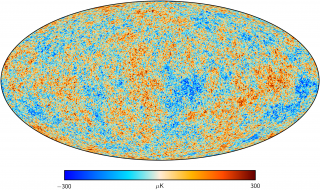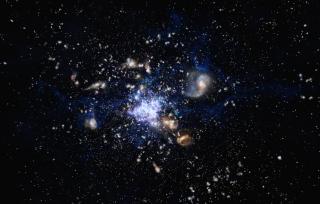Bibcode
Daikuhara, Kazuki; Kodama, Tadayuki; Pérez-Martínez, Jose M.; Shimakawa, Rhythm; Suzuki, Tomoko L.; Tadaki, Ken-ichi; Koyama, Yusei; Tanaka, Ichi
Bibliographical reference
Monthly Notices of the Royal Astronomical Society
Advertised on:
6
2024
Citations
12
Refereed citations
10
Description
Low-mass galaxies at high redshifts are the building blocks of more massive galaxies at later times and are thus key populations for understanding galaxy formation and evolution. We have made deep narrow-band observations for two protoclusters and the general field in COSMOS at z ~ 2. In a clumpy young protocluster, USS1558-003, at z = 2.53, we find many star-forming galaxies well above the star-forming main sequence of field galaxies at the low-mass end ($M_{\star }/\mathrm{{\rm M}_{\odot }}\lt 10^{8.9}$). This suggests that some environmental effects may be at work in low-mass galaxies in high-density regions to enhance their star-formation activities. In the core of this protocluster, we also find enhanced star-formation activity of middle-mass galaxies ($10^{8.9} \lt M_{\star }/\mathrm{{\rm M}_{\odot }} \lt 10^{10.2}$) while such trends are not observed in a more mature protocluster, PKS1138-262 at z = 2.16. We expect these activities to be mainly due to galaxy mergers/interactions and differences in the amount of cold gas accretion. As one piece of evidence, we show that the star-formation activity within individual galaxies in the protoclusters is more centrally concentrated than those in the field. This is probably due to enhanced interactions between galaxies in the protocluster, which can reduce the angular momentum of the gas, drive the gas towards the galaxy centre, and lead to a central starburst.
Related projects

Anisotropy of the Cosmic Microwave Background
The general goal of this project is to determine and characterize the spatial and spectral variations in the temperature and polarisation of the Cosmic Microwave Background in angular scales from several arcminutes to several degrees. The primordial matter density fluctuations which originated the structure in the matter distribution of the present
Rafael
Rebolo López

Molecular Gas and Dust in Galaxies Across Cosmic Time
Two of the most fundamental questions in astrophysics are the conversion of molecular gas into stars and how this physical process is a function of environments on all scales, ranging from planetary systems, stellar clusters, galaxies to galaxy clusters. The main goal of this internal project is to get insight into the formation and evolution of
Helmut
Dannerbauer